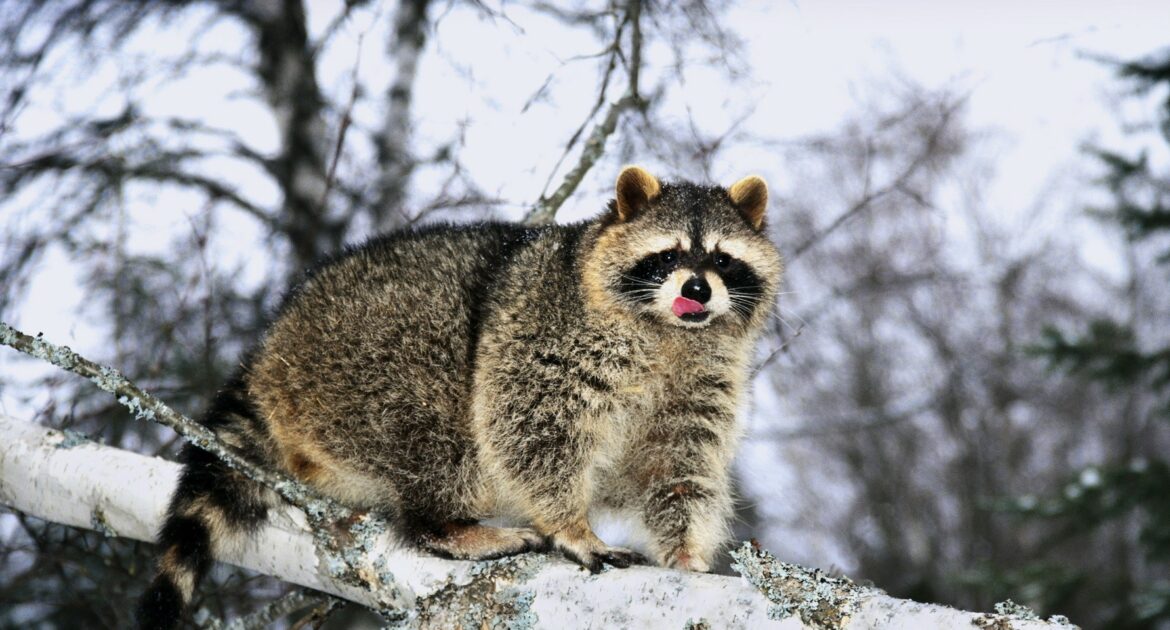Wild raccoons are not exactly desirable houseguests. They are often are associated with property destruction and the presence of dangerous diseases such as rabies. But at the same time, they serve an important role in the natural order of things and for that reason it is often illegal to trap or kill them. So what are Scarborough residents to do when their property is about to be overrun by these wild animals? Today we’ll examine how through humane wildlife control, Scarborough residents can rid themselves of raccoon problems safely and without causing harm to the animal or ecosystem.
Raccoons are one of few urban animals to be active through out colder months.
When to Expect Raccoons
Raccoon presence in Scarborough will be most visible during the fall. This is because, in a raccoon’s world, fall is the season that triggers the search for warm safe dens. Most attics, barns, and sheds fit those requirements perfectly. Once one or more raccoons have established a den on your property, removal becomes a priority.
For the first six months of each year raccoons mate with peak mating activity taking place in February. The resulting raccoon babies, called kits, are born after a little more than 6 weeks of gestation. Within another twelve to thirteen weeks these kits are ready for life on their own. Now imagine all the raccoons born in the previous cycle, having completed their nurturing phase and successfully detaching from their mothers now hunting for their own dens this fall. This is the reality of life in an environment that is shared by raccoons. As soon as raccoons sense the drop in temperature that signals the approach of the colder seasons, they begin to look for dens in which they can weather the season.
Raccoon Winter Habits
In winter, the animals enter a mild version of hibernation called torpor. During torpor, raccoons do very little. Their bodies all but shut down as they slumber deeply. This allows them to conserve energy levels and body fat. If there is a warmer period during the winter, raccoons will come out at night to forage for food. Scarborough residents can also expect to see some activity towards the end of winter as January and February fall in the raccoons’ mating season.
Raccoons are adaptable in all 4 seasons.
Getting Rid of Raccoons
Trying to get rid of raccoons yourself can be time-consuming and frustrating. Especially since there are many technical details of raccoon control that the typical property owner does not know and these may lead to failed DIY raccoon removal attempts. Not to mention the embarrassment of feeling like the raccoons have won the battle.
Some attempts may even become dangerous if the expertise of trained animal control professionals is absent. For example, a raccoon in your home during the winter is possibly a mother nursing a litter of kits. If approached, this raccoon will do all that she can to protect her babies. This puts both you and the raccoon at risk. This danger is multiplied for human beings when we consider that raccoons are known vector animals for rabies.
How to Take Action
This fall and winter do not allow raccoon behaviour to get the better of you. Prepare for their arrival by enlisting the wildlife experts at Skedaddle to raccoon-proof your home. When it comes to humane wildlife control, Scarborough residents can rely on us. Our protection services focus on establishing and reinforcing effective barriers to prevent raccoon invasions on your property. If raccoons have already taken up residence in your space, Skedaddle is the team you need. Our triple approach includes professional evaluation. Removal, cleaning and sanitizing. We will then future proof your home to prevent any further invasions. And with our lifetime guarantee, you can rest easy knowing your home is raccoon free for years to come.






